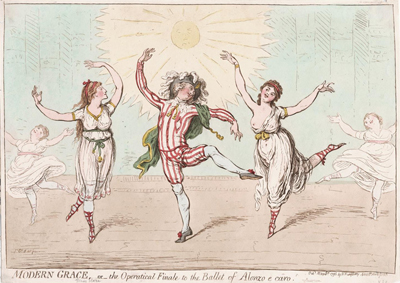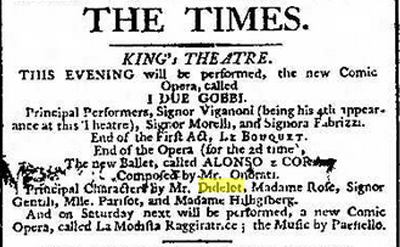Modern Grace, or the Operatical Finale to the Ballet of Alonzo e Caro
Modern Grace is the second of three prints devoted to the ballet performers Charles and Rose Didelot. who had arrived in London from Paris to great acclaim in February 1796. Already famous, Charles had visited England in 1790 with his first wife, Julie-Louise, who took on mostly minor roles while he was featured dancer. But they seem to have left suddenly after a quarter, possibly because of an illness of Julie's. When Charles returned in 1796 it was with his second wife and prima ballerina, Rose. Their performances were much anticipated.

[May 5, 1796]
© Lewis Walpole Library, Yale University
In this print, they are shown performing a ballet choreographed by Giacomo Onorati based on a the novel, The Incas: Or, The Destruction of the Empire of Peru, by Jean-François Marmontel. In the novel, Alonzo is a Spaniard, part of Pizarro's troops sent to conquer the Incas. Cora is a native Inca maiden, a kind of vestal virgin dedicated to the sun god and hence prohibited from having anything to do with men. But they fall tragically in love which on one level explains the disapproving look of the sun god behind them. The other dancer with bare breast in the scene is Mlle Parisot who often worked with the Didelots in their ballets as she does in this one. But in Gillray's portrayal, her youthful energy and apparent carelessness with wardrobe malfunctions, seem to have caught Didelot's eye and may account for the stern expression on Rose's face.
As one can see from the ad which appeared in the London Times, the first performance of "Alonzo e Cora" must have been held in late March (the 2nd performance was on April 5, the same evening the ad appeared).

In 18th century London, opera and ballet were often intermingled, with shorter ballet numbers like Le Bouquet appearing as "divertissements" at the end of an act, and longer ones, like Alonso e Cora at the end of the opera itself.
Sources and Reading
- Commentary from the British Museum on Modern Grace, or the Operatical Finale to the Ballet of Alonzo e Caro.
- "Charles Didelot," Wikipedia
- "Rose Didelot," Wikipedia
- "Mademoiselle Parisot," Wikipedia
- Mademoiselle Parisot's shocking pirouettes, Naomi Clifford
- "Jean-François Marmontel," Wikipedia
- Curtis Price, "Italian Opera and Arson in Late Eighteenth Century London," Journal of the American Musicological Society, p. 78.
- Thomas Wright and R.H. Evans, Historical and Descriptive Account of the Caricatures of James Gillray #431.
- Thomas Wright and Joseph Grego, The Works of James Gillray, the Caricaturist; With the History of His Life and Times, p. 211.
Comments & Corrections
NOTE: Comments and/or corrections are always appreciated. To make that easier, I have included a form below that you can use. I promise never to share any of the info provided without your express permission.